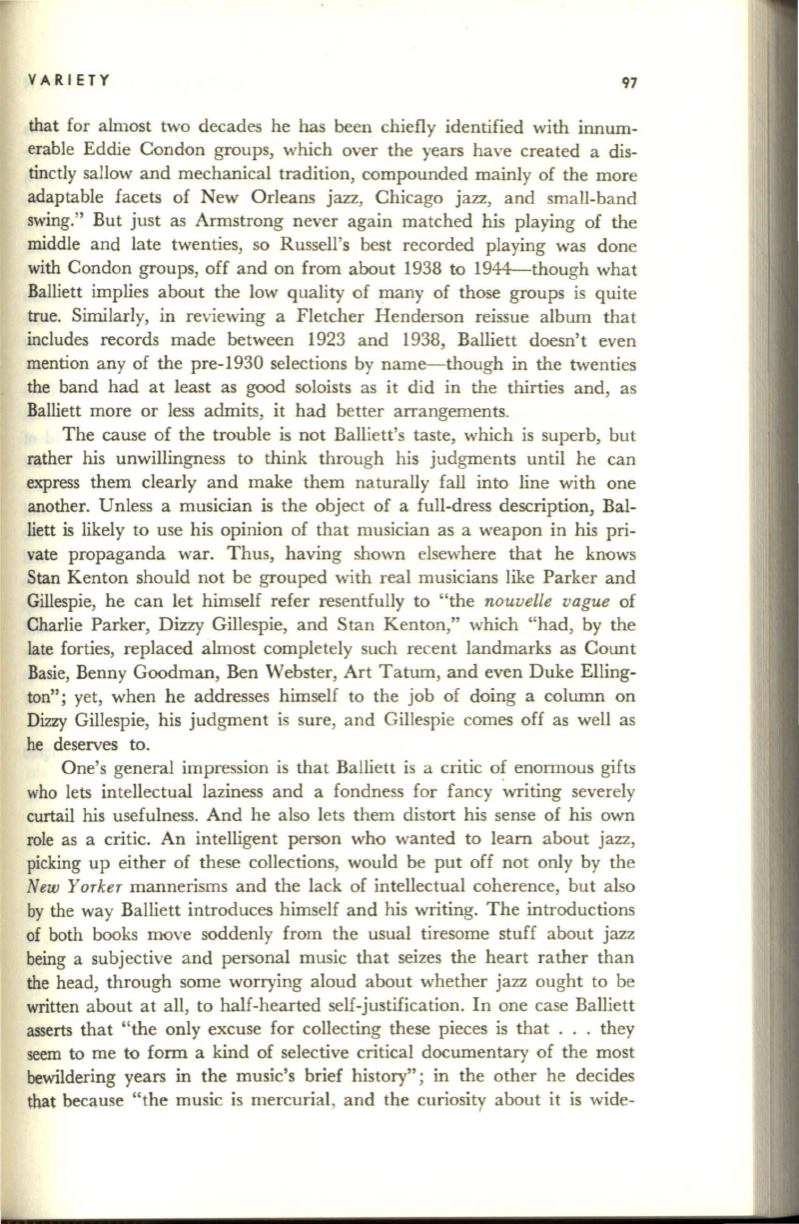
VARIETY
97
that for almost two decades he has been chiefly identified with innum–
erable Eddie Condon groups, which over the years have created a dis–
tinctly sallow and mechanical tradition, compounded mainly of the more
adaptable facets of New Orleans jazz, Chicago jazz, and small-band
swing." But just as Armstrong never again matched his playing of the
middle and late twenties, so Russell's best recorded playing was done
with Condon groups, off and on from about 1938 to 1944--though what
Balliett implies about the low quality of many of those groups is quite
true. Similarly, in reviewing a Fletcher Henderson reissue album that
includes records made between 1923 and 1938, Balliett doesn't even
mention any of the pre-1930 selections by name-though in the twenties
the band had at least as good soloists as it did in the thirties and, as
Balliett more or less admits, it had better arrangements.
The cause of the trouble is not Balliett's taste, which is superb, but
rather his unwillingness to think through his judgments until he can
express them clearly and make them naturally fall into line with one
another. Unless a musician is the object of a full-dress description, Bal–
liett
is
likely to use his opinion of that musician as a weapon in his pri–
vate propaganda war. Thus, having shown elsewhere that he knows
Stan Kenton should not be grouped with real musicians like Parker and
Gillespie, he can let himself refer resentfully to "the
nouvelle vague
of
Charlie Parker, Dizzy Gillespie, and Stan Kenton," which "had, by the
late forties, replaced almost completely such recent landmarks as Count
Basie, Benny Goodman, Ben Webster, Art Tatum, and even Duke Elling–
ton"; yet, when he addresses himself to the job of doing a column on
Dizzy Gillespie, his judgment is sure, and Gillespie comes off as well as
he deserves to.
One's general impression is that Balliett is a critic of enormous gifts
who lets intellectual laziness and a fondness for fancy writing severely
curtail his usefulness. And he also lets them distort his sense of his own
role as a critic. An intelligent person who wanted to learn about jazz,
picking up either of these collections, would be put off not only by the
New Yorker
mannerisms and the lack of intellectual coherence, but also
by the way Balliett introduces himself and his writing. The introductions
of both books move soddenly from the usual tiresome stuff about jazz
being a subjective and personal music that seizes the heart rather than
the head, through some worrying aloud about whether jazz ought to be
written about at all, to half-hearted self-justification. In one case Balliett
asserts that "the only excuse for collecting these pieces is that . . . they
seem to me to form a kind of selective critical documentary of the most
bewildering years in the music's brief history"; in the other he decides
that because "the music is mercurial, and the curiosity about it is wide-


